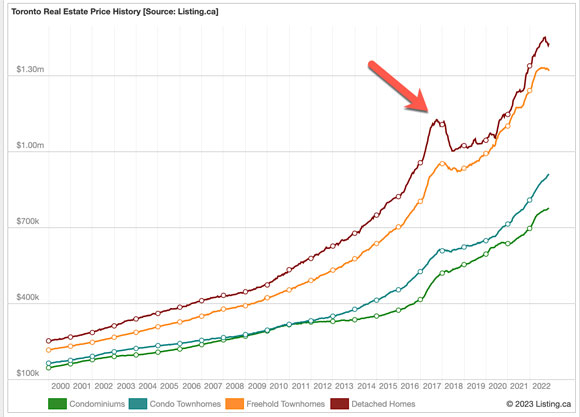You can’t have a more one-eyed view of the property market than the economic narrative currently dominating the conversation in Australia right now.
It goes something like this:
‘Interest rates are rising — property prices must fall!’
I’ve seen market forecasts ranging from a 10% drop to economist Christopher Joye’s recent call that the residential property market will dive 15–25% once rates have hiked 100 basis points.
A 15–25% fall is massive.
If we look back to the last property market crash in the early 1990s, Melbourne suffered more than most.
Stories circulated from agents that they couldn’t sell blocks in the CBD for a $1.
The unemployment rate rocketed.
Older Aussies prepared themselves for the prospect of never working again.
Bankruptcies were 30% higher in the September quarter of 1990 than in the same period of the previous year.
Still, the median fall in residential property prices was only recorded at 10%. (The commercial market was affected far more severely.)
So a 15–25% fall in residential real estate would result in a monumental economic downturn.
But let’s look at rate rises in the context of the real estate cycle — I’m talking about the boom phases of the market cycle.
Take the 2000s property boom for instance.
During the five years from 2000/01–05/06, established house prices increased by more than 110%.
That’s an average of 16.2% a year.
They continued their climb, with median values peaking at the beginning of 2008.
Through 2002–08, we had rising lending rates alongside rising property prices.
By the time we got to the end of 2007, lending rates were around 9–10%.
This was not a solo event.
In fact, if you look back at the lead up to all the peaks in the property cycle — 1973, 1989, and 2008 as mentioned above — you’ll find lending rates increased alongside prices.
The point here is that it’s speculation that drives the property market. Lending rates are a part of that — but they are not the only component.
There are multiple influential factors.
The main argument right now is to do with our high debt-to-household income.
Recent purchasers have been fixing in rates at around 2%.
1% increases mortgage rate costs by a third.
If variable rates rise to 4%, we’re looking at a doubling of costs. That’s significant.
This means more money is going into servicing debt levied against land and less into the productive sectors of the economy.
Afterall, this is why we have a boom/bust property cycle in the first place.
But if you don’t study your cycle history — and think that prices are about to collapse in the shorter term — you risk missing out on what I believe will be a continuation of rising prices for a few years yet.
A few factors that could play into this would include:
1. Off-set accounts.
This is an account linked to a home loan that works just like a transaction or savings account with a redraw facility.
It enables mortgagees to ‘offset’ the balance in the account against their home loan balance and only be charged interest on the difference.
The savings can be significant. The buffer protects you in an environment of rising rates.
And guess what?
There are record amounts stashed away in offset accounts.
$232 billion to be exact.
An increase of nearly 15% — or $30 billion — in the past 12 months.
This is reducing interest payments and shortening loan terms.
These owners are not facing imminent mortgage stress. In fact, financial advisers are encouraging many to redraw and invest in additional property.
2. Blockchain/buying in groups.
Working on the ground gives me a fair bit of insight into growing trends in the real estate market. And over the last 12 months, I’ve seen a decent uptick in enquiry from families grouping together to purchase.
The same is happening with platforms that allow buyers to get into the real estate market ‘one brick at a time’ by taking shares in a property.
The point here is that the technological boom and the blockchain are advancing trends in fractional lending and reducing transaction costs.
3. Rising rents.
Vacancy rates are close to 0% in many of the smaller states and territories by population.
It’s a landlord’s market.
This means that rents can be hiked on the back of multiple tenancy applications for the few homes available.
This increases the earnings of the land. It feeds into rising land prices. It also increases the amount a bank is willing to lend.
Speaking of which, I’ve had more cash buyers approach me for assistance over the last 12 months than ever before. I’m talking about older Aussies taking savings out of term deposits and investing in real estate for better yields.
With saving accounts gifting so little, why wouldn’t you?
4. Government grants.
Both major parties have spruiked affordable housing reforms to policies that promise to keep land prices rising.
Not to mention the states and territory’s own ‘affordability’ initiatives.
Grants, shared equity schemes, stamp duty cuts, etc…you name it. For better or worse, the consequence is higher land prices, not lower.
It’s also worth mentioning that in our post-COVID technological era — with more working from home and less wasted time commuting — setting up small online businesses on the side to bring in additional sources of income has never been easier.
The e-commerce sector saw a ‘dramatic’ rise over COVID — and post-COVID; these trends will likely continue to develop.
While it’s reasonable to expect the bigger capitals — Melbourne and Sydney — to slow, the ‘cheaper’ capitals — Adelaide, Perth, and Hobart, for example — are still providing ample opportunity for investors to dip in around the $400–600K mark.
These are not overinflated markets by any means.
As mentioned, they have rising rents alongside real estate that still looks cheap compared to the larger capitals.
So in short — whilst the cycle historically show us that rates will eventually increase beyond an owner’s ability to service the debt — we’re not there yet!
I believe we have a few more years to go.
If you want to know why I’m so confident, you can find out more here!
Best wishes,
 |
Catherine Cashmore,
Editor, The Daily Reckoning Australia

